#visigoth and ostrogoth..
Explore tagged Tumblr posts
Text
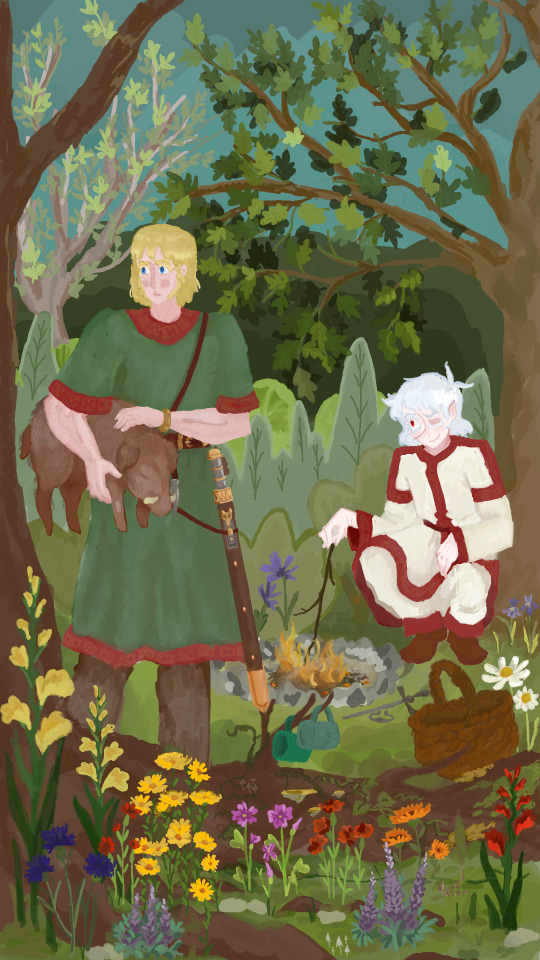
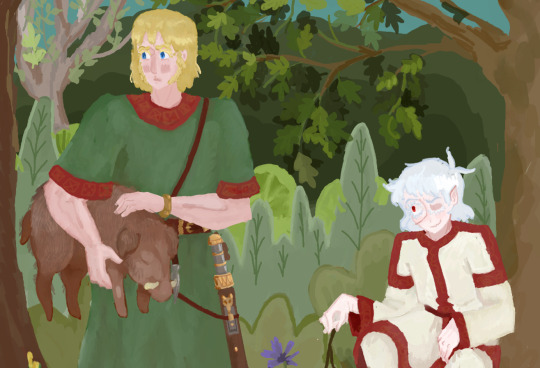
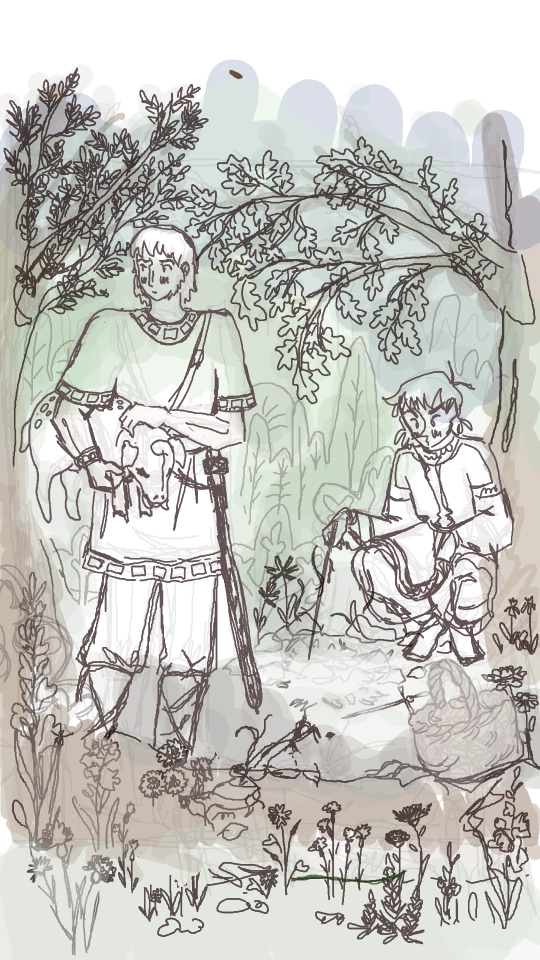
torture by accidental time travel
#hetalia#aph prussia#hws prussia#aph germany#hws germany#zimejumai#visigoth and ostrogoth..#i was going to add some birds but i decided against it because i already expanded the back+foreground so much lol#i liked stylistically the short tunic for Ludwig more but the long one is histoeically accurater#accurater* the short one serves too much roman soldier on his day off
38 notes
·
View notes
Text
Concept: a time traveling 5th-century germanic girl COMPLETELY misunderstands the modern desire for a “goth gf”
24 notes
·
View notes
Text
Gotischen Adlerfibeln

This pair of so called “eagle” brooches, were found in Rhenen, the Netherlands. Their origin however comes from many kilometers away, either being Visigothic (Iberian Peninsula, broadly Spain) or Ostrogothic (Northern Italy to Ukraine).
The grave’s early date might suggest that this person was a first generation “immigrant”, having moved from the Gothic to Merovingian empire and lived a full life there.
Gothic brooches depict the bird with a round belly, open wings and a triangular tale, being symmetric from the neck down. The head in profile, faces to the side. A pair of brooches in this fashion face each other when being worn. They were worn on the shoulders and were most often heavily decorated in gold and garnet, but less intricate examples exist, such as this one.
Rijksmuseum van Oudheden, Leiden, Zuid Holland - The Netherlands
Museum nrs Rh 373 Aa & Rh 373 Ab
Found in Rhenen, Utrecht - The Netherlands
#frankish#merovingian#viking archaeology#archaeology#carolingian#charlemagne#field archaeology#viking mythology#merovingian archaeology#germanic mythology#gothic#Ostrogoth#visigoth#Iberia#Theodorik#netherlands#Dutch#norse mythology#anglo saxon#field archaeologist#vikings#odin#frisian#viking#germanic#germanic folklore#germanic archaeology#historical jewelry#brooch#Fibula
58 notes
·
View notes
Text
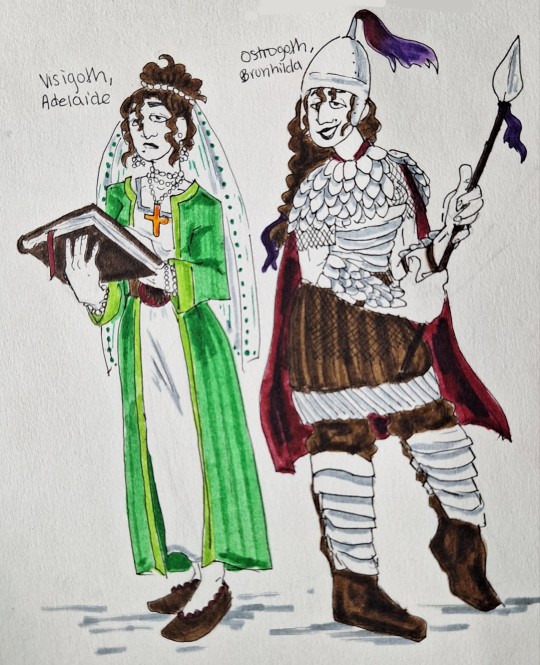
it's about time i made Hetalia OCs:
presenting the Visigothic Kingdom and he Ostrogothic Kingdom, two sisters in Late Antiquity
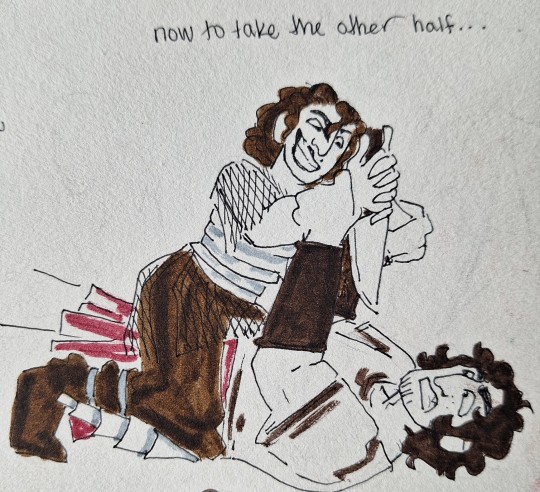
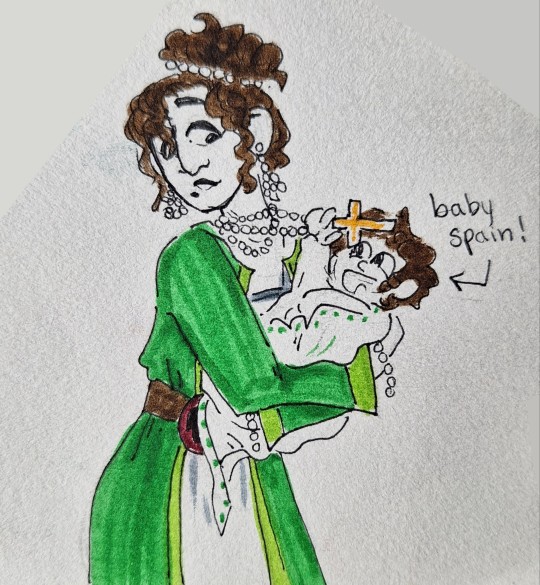
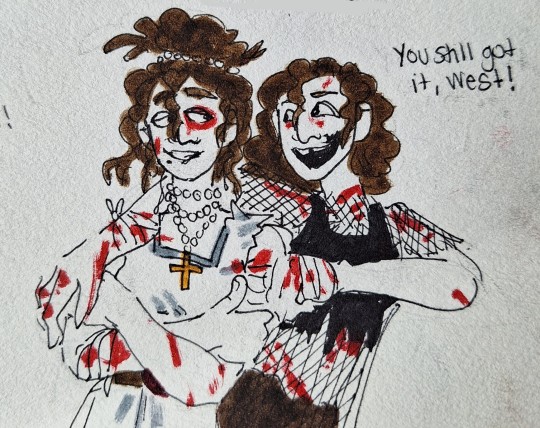
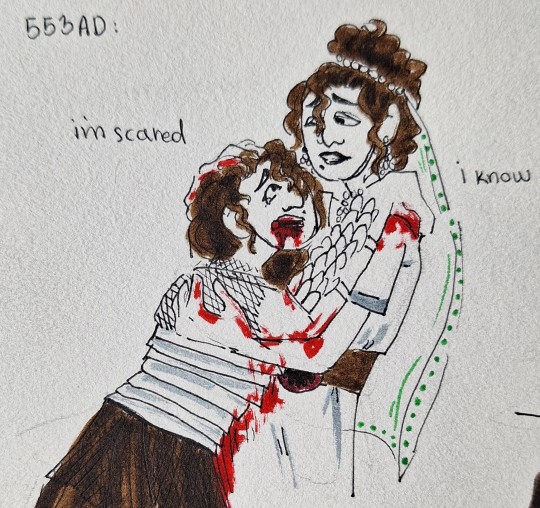
Lore post here!!
#hetalia#historical hetalia#hetalia OC#historical hetalia OCs#visigothic kingdom#ostrogothic kingdom#hetalia ancients#aph ancient rome#hws ancient rome#hetalia antiquity#my life has been ruined my this fuckkng show#source: history major
33 notes
·
View notes
Text
"Quick map I made showing the area of origin of the East Germanic languages in pink, semi-fading since concept of land use differed & it's impossible to know borders. In cards are given possible locations, -timeframe & -causes of the extinction of select East Germanic languages." - 13.12.2021 "In brackets is information that is uncertain. Also keep in mind causality issues - like say for example some languages might have never gone extinct due to adopting Latin in the first place had they not seen expulsions by other tribes moving westwards in the first place." - 13.12.2021
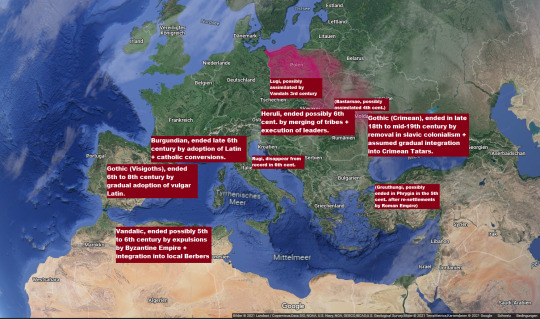
#german#germanic#historical map#maps#map#east germanic#gothic#vandalia#visigoths#burgundians#ostrogoth#language#linguistics
5 notes
·
View notes
Text
Historically, the architecture of Gothic peoples (not to be confused with Gothic architecture) was Roman-esque (not to be confused with Romanesque architecture).
1 note
·
View note
Note

Do not approach them, lest they bury their heads in the sand and get their earrings stuck.
do you have any facts about goth culture
Goths dress dark to hide themselves. Goths who are easier to see from their brighter clothing are called Visigoths.
4K notes
·
View notes
Text
has- has encyclopedia britannica always been paywalled?
#quizlet quora britiannica#what is wikipedia gunna cost money next?#fuck off#fuck your capitalism#i didnt wanna learn about the ostrogoth and visigoths anyway#fuck you
0 notes
Photo

The barbarian invasions of the 4th to the 5th century and the Romano-barbarian kingdoms
via cartesdhistoire/instagram
🇩🇪 “TaschenAtlas – Weltgeschichte”, Klett-Perthes Verlag, 2004
🇩🇪 "Putzger, Historischer Atlas", 1994
4th Century: Barbarian populations begin settling as fœderati (allied peoples) along the borders of the Roman Empire. 378: The Visigoths invade the Balkan Peninsula, reaching as far as Greece. Near Adrianople, they inflict a significant defeat on the Roman army, marking the first serious Roman loss on their own territory. 400: The Burgundians settle in the region between the Rhine and the Main rivers. 402: The Visigoths invade Italy but are stopped by the Roman general Stilicho near Verona. 406: Various barbarian groups, including Vandals, Suebi, and Alans, cross the frozen Rhine, initiating widespread incursions into Roman territory. 407: The Caledonians (native tribes of Scotland) force the Romans to withdraw from Britain. 410: Alaric, king of the Visigoths, conquers and sacks Rome, shocking the empire. 412-418: The Visigoths settle in parts of Gaul and Spain, establishing a federated kingdom. 421: The Franks, led by Clovis, begin settling in northern Gaul. 429-439: The Vandals, under King Genseric, conquer North Africa and parts of Spain. They establish a kingdom that is initially recognized by the empire as federated but later becomes independent. 442: Rome formally cedes all its North African territories to the Vandals. 450: The Jutes, Angles, and Saxons begin settling in the British Isles, marking the start of the Anglo-Saxon migration. 451-453: The Huns, led by Attila, invade the western Roman Empire. 452: Pope Leo I, known as Leo the Great, meets Attila the Hun near the Mincio River and persuades him to abandon his campaign into Italy. 455: The Vandals, led by Genseric, sack Rome and pillage the coasts of Spain, Greece, and Italy. 475: The Eastern Roman Emperor Julius Nepos formally recognizes the Kingdom of Toulouse, established by the Visigoths. 476: The fall of the Western Roman Empire: Odoacer, a barbarian leader, deposes the last Western Roman Emperor, Romulus Augustulus, and declares himself King of Italy. 488-489: Theodoric, King of the Ostrogoths, invades Italy and defeats Odoacer in battles at the Isonzo, Verona, and the Adda River. 493: Theodoric captures Verona and has Odoacer assassinated. As master of Italy, Theodoric seeks coexistence between the Goths and the Roman population. 496-507: Clovis, king of the Franks, defeats the Alemanni at the Battle of Tolbiac (496) and the Visigoths at the Battle of Vouillé (507), expanding Frankish control over Gaul.
75 notes
·
View notes
Text
Bring me more drawings of cute supernatural beings in heels

ocs. . the usual
#i mean seriously#go on#gather all the Ostrogoths and Visigoths#ride like an arctic storm across the world#this is a therion reference
305 notes
·
View notes
Note
There is a very recent (couple of weeks ago?) Spanish publication on the famous Visigothic cloisonné eagle brooches. Apparently, and according to the two researchers, these cannot be eagles because they appear in female burials, and thus cannot have warrior-related burial goods... They suggest those are peacocks rather than eagles, because they are 'feminine' animals, and not warrior-related.
(just to be clear, I think that this new interpretation is... not solid)
My god I have seen so many of these “they must be eagles because their beaks curve”.
I have not once found a source that gives good reasoning for why bird brooches would depict eagles. And I have to say, peacocks are a new one…
More likely explanations are corvids because of the eddic texts, animism, beasts of battle,… but someone who claims to be certain of this is talking nonsense because it’s nowhere written down or anything. It’s a guessing game.
Also depictions of birds of prey with… well prey exist, and although the Pavo genus are omnivores, they’re not hunters. Also duck shaped brooches and appliqués exist, minimizing the possibility of it being a peacock.
The Pavo genus is a tropical bird, with origins in for example India. Garnet is found in South East Asia so tradesmen might have seen multiple peacocks on their journeys. But no one really starts animal devotion out of nowhere for no reason. Why would they anyways?
A lot of gothic brooches are inlayed with garnet, believed by some to be resembling Freya’s Brísingamen. Although one can discuss the exact look of “Freya’s flaming necklace”, garnets do give an appearance described as “flaming red”. So they might be very feminine yes, and this style was indeed worn by women, birds themselves were not exclusively worn by or meant for women.
I agree 1000% with you. Not the most solid theory. But so is mine… that’s just Germanic archaeology
#frankish#merovingian#viking archaeology#archaeology#carolingian#charlemagne#field archaeology#viking mythology#merovingian archaeology#germanic mythology#visigoth#ostrogoth#gothic germans
15 notes
·
View notes
Note
Hi Hilary! I could use some help with something. Do you know some topics for historical tangents a history professor (Hob) could go on while talking to some students? Like some interesting discussion ideas? I was not a history major and I’m now drawing a blank 😅 I’d appreciate it greatly!
"Right, morning everyone... MORNING... yes, we all do know it is morning and I would like to remind everyone that it's not my fault we were scheduled at eight bloody AM. Consider it building character. Great. Let's get started. Can we put the phones down, please. In my day we didn't even have phones. No really. We didn't. Really didn't.
Anyway, so where were we? Ah, yes. End of the Western Roman Empire circa 476 CE, which stands for the secular Common Era, which historians now generally use instead of the Christian A.D. Anno Domini, which trust me, they used when I was born, because I am very old. Ah, you're laughing again, because you think I'm joking. Which, er, I definitely am. Anyway, the so-called collapse of the Roman Empire is one of the most mythologized events in the Western historical canon, and there are accordingly a lot of misperceptions about what happened and how. As we covered in the last class -- well, can anyone tell me what we covered last class?
Anyone?
Anyone?
Come on, one of you, just raise your hands. I don't bite.
Fine, all right, I'll do it myself. Again. Last class, we covered the eventful fourth century in Roman history, where the empire split into western and eastern halves, eastern Emperor Constantine converted to Christianity, and established his capital in Constantinople, which would later get the works from the Turks and become Istanbul. The western capital moved to Ravenna in 402, and it had been in Milan before that, not Rome. No longer the center of power as it had been for many centuries beforehand under both the empire and the republic, Rome was infamously sacked in 410 by the Visigoths under King Alaric I. The Supergoths. The Ubergoths. The Verygoths. The Turbogoths. All right, I'll stop. The Visigoths had formerly been a Roman client kingdom in the south of Gaul, which is the modern country of -- anyone?
Anyone? Anyone? Oh come on.
Yes, thank you Sarah, it was in fact France. See everyone? Not that hard. Now that we're up to speed, right, the so-called End of Rome in 476, when the last Western emperor, Romulus Augustulus, was deposed by Odoacer, general of the Ostrogoths. Not the Visigoths. Definitely different thing here. The Alsogoths. The Othergoths. The Ohgodthosegoths. I'm sorry, I'm sorry. I swear I will actually stop. But the common narrative from then is that Rome just bloody disappeared altogether, the Dark Ages started, it was grim and miserable and murdery all the time, everyone forgot how to do scholarship or art or religion or anything else, and then miraculously a thousand years later, woo, the Renaissance! Everyone sorted their heads from their arses and could do maths again! I'm sorry about saying arses. Please don't report me to HR, they've had enough of me already. Anyway, this argument, despite its long-time supremacy in the Western historiographical canon and Western popular culture, doesn't make sense on any number of levels. And that is because? Can anyone give me just one reason to start with?
Anyone?
Anyone?
Sarah again, yes, thank you. I appreciate you greatly, Sarah. Yes, for one thing, the Eastern Roman Empire still bloody existed! It was literally that meme where we're announcing that Rome is dead, Constantinople wants us to stop telling everyone that they're dead, and we sigh that sometimes we can still hear their voice. Yes, I know what a meme is, don't look so surprised. The city of Constantinople became the center of Roman culture and power, though we call it the Byzantine empire to distinguish it from the pre-476 Roman empire. It used Greek instead of Latin as its primary culture and language, it was Orthodox Christian instead of Catholic Christian, and while it was no longer the multinational power player that its predecessor had been, it still produced some heavy hitters. Such as Emperor Justinian in the sixth century, who actually, albeit briefly, reconquered the territories of former Rome in the west, and was married to the very fascinating Empress Theodora. We'll have to get back to her, but anyway, in the territories of Former Rome, such as modern-day Spain, France, and Germany, there were still client kingdoms who were directly descended from Rome and who premised their new independence on their Roman inheritance. The Visigoths -- yes, them again -- in Spain, the Merovingians and the Franks in France, the Angles, Saxons, and Jutes in Germany, and other. So tell me, can we really say that Rome collapsed, exactly, and/or disappeared, instead of just dissipated and re-formed? We still had Latin as the language of state administration, the Roman Catholic Church as the supreme religious and cultural arbiter, and other major innovations that would last through the Middle Ages. Where does this whole Dark Ages thing come from?
Anyone?
Anyone aside from Sarah?
Oh, God's wounds. All right then. The idea that Rome disappeared overnight and took everything good with it is a projection, a fiction, popularized by proto-Renaissance and Renaissance writers who wanted to legitimize their look back into the past. We're getting ahead of ourselves, but the idea of the Dark Ages as this backward slovenly time of idiocy and misery -- it just gets me very worked up, all right?! Yes, written texts and certain other traditional markers of historic narrative became much scarcer than before, and we don't know as much about it as we do the more meticulously documented societies on either side, but it's only dark because we've decided that Rome, the brutal excessively slave-owning militaristic expansionist violent empire par excellence, was the marker of all culture and the peak of Western civilization for all time and nobody else could ever come close! This is how we get bloody Game of Thrones insisting that the medieval era was always filthy and dark and full of rape and violence and morally awful people -- so tell me, George, which part of your fantasy novel, the dragons or the ice zombies, were we expected to read as actual literal truth? It's just because we want to protect the idea of ourselves as so much better than people in the past, and the past itself as full of terrible violence that is somehow worse and more primitive than our violence, and that surely we could never do that because we're so much better! Which is total bullshit! Bullshit!
...yes. Thank you. Right. I'm fine. I'm absolutely fine, I apologize for that. Just a bit of a trigger for me. We'll get back to the lesson now, yes. I'm warning you, though. If you use Dark Ages uncritically in your essay, I am knocking you down a full grade. No matter what."
#acedragontype#ask#history#hob gadling#you're welcome to use all/parts of that as you wish XD#ahem#or: how the fall of the western roman empire gets Hob to blow a gasket about game of thrones
89 notes
·
View notes
Text
Visigoth to Goth : How alt fashion history grew through gothic literature, music, and style
youtube
Gothic fashion fascinates me, and the goth aesthetic deserves it, from mall goth to whimsigoth. See how the goth style we know developed from the Ostrogoths and Visigoths through gothic literature and Victorian fashion history into goth music and the vampy style we know today. Click here https://foreo.se/ono7 for a 30% discount on the FOREO UFO 3! The first 50 people to use code VI10 get an additional 10% off.
Whether you're a mall goth, Victorian goth, whimsigoth, or just an admirer of the gothic fashion and aesthetic, everyone loves the dark and spooky this time of year for Halloween! But how did the gothic aesthetic become what it is? How did "goth" go from the name of Germanic tribes like the Visigoths and Ostrogoths, to a modern day subculture defined by dark music, black clothes, and vampy makeup. The answer takes us on a journey from the history of the Roman Empire through architecture, literature, the golden age of cinema, and music-- with plenty of dress history along the way.
The word "goth" came into being as the Latin translation of the name of a Germanic tribe in the first century CE, which is a pretty big difference from the gothic aesthetic! After the tribe was split into the Visigoths and Ostrogoths a few hundred years later, this historical gothic fashion was nothing like the dark alt fashion we know! Ostrogothic fashion was bright and colorful, combining colors like scarlet red and leek-green in the same garments! And Visigothic fashion seems to have been just as colorful, drawn in a variety of bright shades in illuminated manuscripts.
How we got from the Visigoths and Ostrogoths to the modern goth aesthetic starts with architecture. The dramatic building style of the High and Late Medieval period was named "gothic" by later Renaissance artists. These artists idealized the Classical style of Rome, and since the Goths had sacked Rome, they called the older Middle Ages architecture "gothic" as an insult. But the medieval gothic aesthetic of building held peoples' imaginations, becoming a defining feature of gothic literature in the 18th and 19th century. Spooky old castles and other Gothic buildings helped give the genre its air of hauntedness and fear and darkness.
Gothic literature is how the words "goth" and "gothic" found their way into the modern subculture! Now associated with the horror genre, silent films began retelling existing Gothic fiction and creating new works in the gothic style, with actresses like Theda Bara and Musidora developing the vamp style that became so popular in 1920s makeup. Gothic cinema remained popular, keeping the dark aesthetic in mind until 1967 when it was first applied to the new genre of music called Gothic Rock! The Doors were the first to be described this way, even though their clothes were decidedly different from the fashion we'd come to call goth. However, other gothic rock musicians in later years did wear much more dramatic stage outfits for performances, and so the goth subculture was born, forever changing the world of alt fashion.
Today, gothic fashion exists in a continual dialogue with other aesthetics. It combines with mainstream style to create corporate goth and dark academia. It's melded with other alt fashions too : with lolita style to create gothic lolita, or blending with cottagecore and fantasy aesthetics to become whimsigoth. And in its own right, goth fashion has countless sub-styles, from mall goth to Victorian gothic and so many more. Whether you prefer alt fashion gothic or Visigothic fashion, there's no denying that the gothic style hasn't survived nearly two millennia for nothing. Happy Halloween, my darling goths!
13 notes
·
View notes
Note
So I know my homoiousios vs. homoousios, and my monophysite vs. dyophysite, and my monothelite vs. dyothelite, and how it all led to the Arab caliphates getting a decent navy and winning the Battle of the Masts.
I don't, and I'd love to! (If you feel like it, obviously.) I'm pretty sure the homoiousios one is about, like, the Trinity or something, but beyond that it's all Greek to me.
(At this point, I feel like I owe @apocrypals royalties or something, but I'm getting a weird kick from doing this on Saint Patrick's Day, so let's do this).
I covered the impact of the monophysite vs. dyophysite split and the Battle of the Masts here, so I'll start from the top.
You are quite correct that the homoiousios vs. homoousios split was, like most of the heresies of the early Church, a Cristological controversy over the nature of Christ and the Trinity. This is perhaps better known as the Arian Heresy, and it's arguably the great-granddaddy of all heresies.
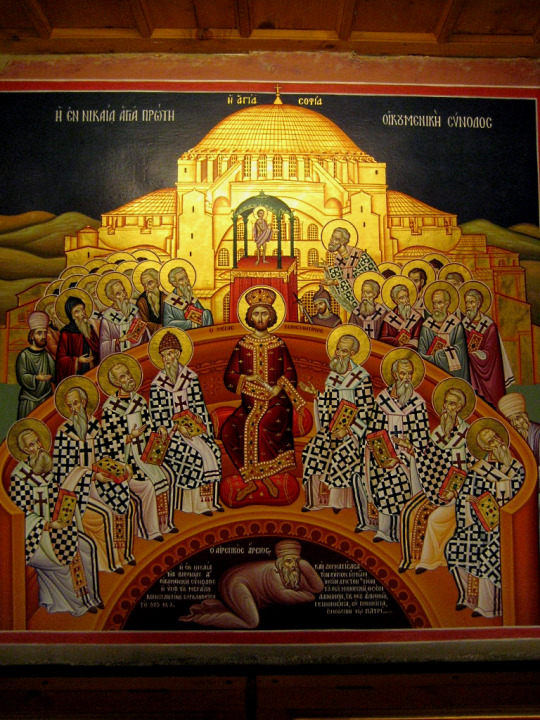
The Arian heresy was the subject of the very first Council of the early Church, the Council of Nicea, convoked by Emperor Constantine the Great in order to end all disputes within the Church forever. (Clearly this worked out well.) In part because the Church hadn't really sat down and attempted to establish orthodoxy before, this debate got very heated. Famously, at one point the future Saint Nicholas supposedly punched Presbyter Arius in the face.
What got a room of men devoted to the "Prince of Peace" heated to the point of physical violence was that Arius argued that, while Christ was the son of God and thus clearly divine, because he was created by God the Father and thus came after the Father, he couldn't be of the same essence (homoousios) as the Father, but rather of similar essence (homoiousios). Eustathias of Antioch and Alexander of Alexandria took the opposing position, which got formulated into the Nicean Creed. As this might suggest, Arius lost both the debate and the succeeding vote that followed, as roughly 298 of 300 bishops attending signed onto the Creed. This got very bad for Arius indeed, because Emperor Constantine enforced the new policy by ordering his writings burned, and Arius and two of his supporters were exiled to Illyricum. Game over, right?
But something odd happened: the dispute kept going, as new followers of Arius popped up and showed themselves to be much better at the Byzantine knife-fighting of Church politics. About ten years later, the ever-unpredictable Constantine turned against Athanasius of Alexandria (who had been Alexander's campaign manager, in essence) and banished him for intruiging against Arius, while Arius was allowed to return to the church (this time in Jerusalem) - although this turned out to be mostly a symbolic victory as Arius died on the journey and didn't live to see his readmission.
....and then it turned out that Constantine the Great's son Constantius II was an Arian and he reversed policy completely, adopting the Arian position and exiling anyone who disagreed with him, up to and including Pope Liberius. While the Niceans eventually triumphed during the reign of Theodosius the Great, Arianism unexpectedly became a major geopolitical issue within the Empire.
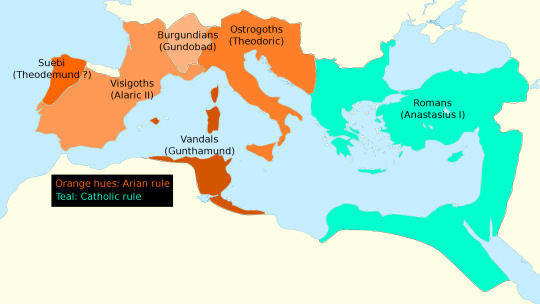
See, both during their exile and during their brief period of ascendancy within the Church, one of the major projects of the Arians was to send out missionaries into the west to preach their version of Christianity. Unexpectedly, Arianism proved to be a big hit among the formerly pagan Goths (thanks in no small part to the missionary Ulfilas translating the Bible into Gothic), who were perhaps more familiar with pantheons in which patriarchal gods were considered senior to their sons.
While they weren't particularly given to persecuting Niceans in the West, the Ostrogothic, Visigothic, Burgundian, and Vandal Kings weren't about to let themselves be pushed around by some Roman prick in Constantinople either - which added an interesting religious component to Justinian's attempt to reconquer the West.
32 notes
·
View notes
Text
thinking about like
an alternate history where there weren't the Visigoths and Ostrogoths
and like what that would mean for modern goth subculture yk
like alternate history where gothic architecture didn't become associated with the horror aesthetic, due to like, perhaps less prominence of the goths, and therefore the goth subculture didn't form from that
and like one possibility is i do think it would be very funny if goths similar to the ones we have now existed, but they just had a different name than the subculture we have now
like goths are just called franks instead now
9 notes
·
View notes